Cupping therapy, an ancient healing practice that dates back thousands of years, has become a trendy wellness treatment in recent years. The practice involves placing glass, bamboo, or silicone cups on the skin, creating a vacuum effect that’s said to promote blood flow, relieve tension, and reduce inflammation.
While many are familiar with the circular bruises that often follow a cupping session — thanks to celebrities like Gwyneth Paltrow and Michael Phelps sporting the marks — fewer people understand what cupping is and what it really feels like.
If you’ve tried cupping, you know it can be a unique and sometimes surprising experience. The sensation of the cups on your skin is unlike anything else; it’s a gentle, but firm suction that can feel like a deep massage. While some people find it soothing and relaxing, others describe it as a bit uncomfortable at first, especially if the suction is too strong.

The feeling tends to vary depending on the area of the body being treated and the practitioner’s technique.
For many, cupping is a way to relieve muscle tension, especially after intense physical activity, or to treat ailments like headaches, back pain, and even anxiety. Traditional Chinese medicine and Middle Eastern cultures have long used cupping for its supposed benefits, and now, in modern wellness circles, it’s touted as a way to detoxify the body and improve circulation.

But what about the aftermath? One of the most noticeable side effects of cupping is the appearance of round, bruise-like marks where the cups were placed. These marks are a sign that the therapy is working, as they reflect the increased blood flow to the area. The intensity of the marks varies from person to person and can last anywhere from a few days to a week, which is something to keep in mind if you’re planning a cupping session.
For some, these temporary marks can be a source of concern or embarrassment, while others embrace them as a badge of healing. But regardless of the physical appearance, the benefits people report often outweigh the temporary side effects. Many feel an immediate sense of relief, whether it’s a reduction in muscle pain, better mobility, or simply feeling more relaxed.

Embracing new experiences and being open to alternative therapies, even if they initially seem strange or intimidating. Cupping, like other ancient practices, has stood the test of time because many believe it works — even if the marks left behind look unusual.
So, have you tried cupping?
What was your experience? Whether you loved it or hated it, there’s no denying that this age-old practice has a way of sparking curiosity and encouraging people to explore wellness in different ways.

